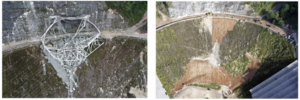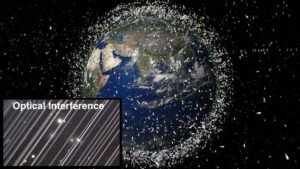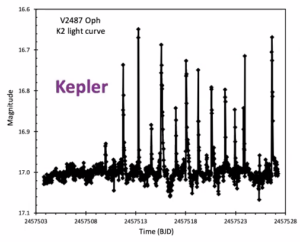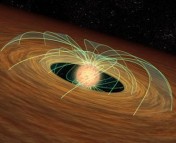Welcome to the Astrobites coverage of virtual events based around the cancelled American Astronomical Society (AAS) meeting! We will report on highlights from each day here, from AAS Press Conferences to grassroots astronomy community meet-ups. If you’d like to see more timely updates during the day, we encourage you to search the #aas239 hashtag on twitter. We’ll be posting once a day during the week, so be sure to visit the site often to catch all the news!

The Local Bubble [image credit: Catherine Zucker]
NSF/AST Community Webinar (by Catherine Manea)
The first event of the day was the National Science Foundation’s Division of Astronomical Sciences (NSF/AST) Community Webinar, a town hall-style event led and moderated by Prof. Debra Fischer, Prof. James Neff, Dr. Ashley VanderLey, and Donna O’Malley. The focus of this webinar was to provide updates on the NSF/AST’s existing and upcoming programs, grants, and fellowships, with particular focus on the recommendations of the Astro2020 Decadal Survey.
Fischer began the webinar by introducing the organization and highlighting its original guiding mission: “to advance the understanding of the universe, to promote US scientific leadership, to build a diverse workforce of scientists and engineers, and to enhance the lives of our citizens.” She highlighted some relevant and important recommendations from the Decadal Survey, namely to:
- “augment and protect individual investigator grants”
- “build opportunities for diversity in [the] workforce”
- “increase transparency [in budgets and proposal statistics]”
- “reduce [the] carbon footprint associated with research”
In summary, “fund people and develop the workforce,” remarked Fischer, a principle that aligns with many of the existing NSF/AST initiatives supporting students, post-docs, and early-career faculty from under-represented and minoritized groups. In addition, Fischer highlights that it is important to ensure that the astronomy community is developing astronomers with flexible, adaptable skills that they can take outside of academia, should they so choose. Fischer next summarized and provided updates on the various ongoing NSF/AST-funded programs and facilities (such as CAREER, REU, PAARE, Mid-Scale Innovations Program, the Atacama Large Millimeter Array, Green Bank Observatory, and Arecibo, among many others).
Some updates included that construction on the Daniel K. Inouye Solar Telescope (DKIST) on Haleakalā Crater, in Maui, HI is complete, and DKIST is now in operation. Fischer emphasized that DKIST is “the largest and most powerful solar observatory on our planet” and will transform the field of multi-messenger astrophysics. DKIST will provide astronomers with the first in-depth, high-resolution look at the Sun’s magnetic fields, opening the door to a better understanding of the effects of magnetism on both the structure of the Sun’s surface and life on Earth.

Before and after images of the Arecibo Observatory. The left image shows the state of the dish well after the 2020 collapse of the dish. The right image is more recent, showing the progress of the emergency clean up crew.
Fischer also updated attendees on the current status of the decommissioned and dearly-missed Arecibo Observatory in Puerto Rico. After two breaks in the cables stabilizing the radio receiver, the NSF decided to decommission the instrument in 2020 and began the process of demolishing it. Fischer announced that the emergency cleanup team has now “safely removed approximately 14,000 damaged panels, or 35% of the reflector area” of the instrument. In addition, the team repaired several hundreds of feet of concrete rim wall, installing organic erosion control measures (coconut fiber matting and seeding) that encourage native vegetation growth.
Neff followed with an update on recent and upcoming NSF/AST-funded programs, including various fellowships for astronomers at all career stages. Neff highlighted that PAARE in particular is looking for applications, with a proposal deadline of February 7th. PAARE is a program that seeks to form partnerships between the NSF and various institutions to foster a diverse, equitable, and inclusive environment in astronomy research and education.

Bottom Left: A satellite-streaked optical CCD image, an example of the negative effect that the growing population of low Earth orbit satellites have on astronomical science. (Credit: NSF/Ashley VanderLey) Background: An artist’s impression of a satellite-swarmed Earth, something that is a growing reality. (Credit: ESA)
VanderLey finished off the presentation portion of the webinar with a summary of the NSF’s recent activities related to new satellites. The growing number of satellites in low Earth orbits is a major concern for astronomers worldwide. Current projections suggest that the number of satellites circling the Earth will exceed 50,000 by 2028! VanderLay emphasizes that building telescopes in remote locations is no longer sufficient to prevent interference. The NSF is thus advocating for international recommendations and regulations on satellite design to minimize interference with astronomical observing. Many satellite-producing companies, such as SpaceX and Amazon, are beginning to take into account the concerns of the astronomy community. For example, Amazon’s Kuiper satellite will be designed with a dimming visor to minimize its intensity. Vanderlay notes that she is “very excited to see the movement” of these companies in alignment with the needs of the astronomical community and hopes that more companies will sign on to work with the astronomical community to mitigate satellite interference.
The event ended with questions from the audience. One question arose highlighting concerns for the high NSF budget dedicated to upcoming facilities, something that could risk funding for individual grants. Fischer assured attendees that the NSF/AST’s top priority will be individual grants and increasing the availability of individual funding gradually, in line with the recommendations of the Decadal Survey. To round off the event, Neff emphasized that “everything will be guided by Astro2020 Decadal Survey.”
Live-tweeting by Catherine Manea
Press Conference: Evolving Stars & Their Activity (by Macy Huston and Huei Sears)
Today’s first press conference focused on post-main sequence stars. First, Andrew Nine from the University of Wisconsin-Madison discussed blue lurkers in M67 and their white-dwarf companions. Classic blue stragglers are bluer and brighter than the main-sequence turnoff of a cluster, thought to form when stars merge or transfer mass. Blue lurkers, on the other hand, are stars on the main sequence that rotate at anomalously fast rates, corresponding to very young gyrochronological ages. Eleven of these were discovered on the main sequence of M67 as part of the ongoing WIYN Open Cluster Study (WOCS), eight of them residing in binary systems. Andrew’s team observed these eight binary blue lurkers with the Hubble Space Telescope. The team detected two white dwarf companions based on their far-ultraviolet flux out of a sample of eight blue lurkers, or 25%, which fits expectations from simulations. It is plausible that the blue lurkers are the products of mass transfer and are low-luminosity analogues to the classical blue stragglers.
Press Release
Next, Samuel Swihart from the Naval Research Laboratory presented a unique binary system containing a gamma-ray-bright neutron star and a very low-mass proto-white dwarf. Most stars are born in binary systems. The more massive star eventually goes supernova and sometimes leaves behind a spinning neutron star (pulsar), which gradually loses energy over time. A millisecond pulsar (MSP) can form through a “recycling” process, where the companion star expands and its material accretes onto the neutron star, speeding up its rotation. Most binary MSPs have distant white-dwarf companions, while some have short periods where the companion is being consumed. MSP 4FGL J1 120.0-2204 (shortened to J1120) is a gamma-ray source that has an X-ray and optical counterpart. So, what is it? Spectroscopy with the NOIRLab SOAR telescope reveals a slowly contracting hot object, the precursor to an extremely low-mass white dwarf, orbiting an unseen companion. J1120 is the first system ever discovered in the penultimate phase of the MSP recycling process.
Press Release

Kepler K2 light curve of V2487 Oph [image from Bradley Shaefer]
The final presentation today came from Bradley Schaefer from Louisiana State University, Baton Rouge, who discussed the recurrent nova V2487 Ophiuchi’s extreme superflares. V2487 Oph, which erupted in 1900 and 1998, is one of just 10 recurrent novae known in the Milky Way. The Kepler Space Telescope revealed that this source has extreme superflares roughly once per day lasting for about an hour, with very high energy levels of 20 Mega-Carringtons per flare. (A “Carrington” is equal to the amount of energy released in the Carrington event, the largest coronal mass ejection in recorded history.) In 1989, Brad discovered and named superflares — stellar flares with energy greater than 100 Carringtons and durations on the order of hours. These events are caused by the reconnection of twisted magnetic field lines and occur in all types of normal stars, including those like the Sun. The radiation from superflares can kill all unprotected life and destroy ozone layers, allowing in sterilizing ultraviolet light, meaning that they make planets around stars extremely uninhabitable. V2487 Oph is the most extreme superflare star, with the most frequent flares, >10x more energy per flare than any other superflare star, and >100,000x the yearly energy budget. How these flares can be so powerful poses an interesting challenge for theorists.
Press Release
Live-tweeting by Huei Sears
Youtube recording
Press Conference: Mapping Local Structure & More Evolving Stars (by Zili Shen)
The second press conference today is about Mapping Local Structure & More Evolving Stars. We start with Catherine Zucker from the Space Telescope Science Institute and Center for Astrophysics | Harvard & Smithsonian. She tells us the ultimate origin story by explaining how all nearby star formation (within ~ 500 light years of our Sun) began. Her team uses Gaia data to retrace the star formation history around the Solar neighborhood. Here’s how it happened: around 14 million years ago, a chain of supernovae blew out the 1,000-light-year-wide Local Bubble. The shockwaves from the supernovae piled up ambient gas into an extended shell and triggered star formation. Nearby stars were born on the surface of the Local Bubble, riding outward as it expanded. Our Sun was 1,000 light years away when the bubble first started forming. But about 5 million years ago, the Sun’s path through the galaxy took it into the bubble and now we happen to be near the bubble’s center. The next step is to search for more supernovae-driven bubbles and study how they interact in the Milky Way.
CfA Press release | Hubble Press release | Project website
Zooming back one million years in the history of our Sun, Seth Redfield of Wesleyan University presents a project led by Hunter Vannier, who is now a graduate student at Purdue University. They are particularly interested in the interstellar medium (ISM), the stuff between stars inside a galaxy. All stars expel particles into the ISM, and in the case of our Sun, the particle stream carves out our little region in the ISM called the heliosphere. Since the Earth sits inside the heliosphere, the cosmic rays we receive depend on the conditions of the ISM outside. Seth pointed the Hubble Space Telescope in the direction that the Sun came from, using it as a rear-view mirror. Since the ISM is too diffuse to be directly imaged, they use absorption spectroscopy to locate the gas clouds that the Sun traveled through in the last one million years. They reconstructed the Sun’s path through these clouds and found that we are currently departing the Local Interstellar Cloud. This technique can help scientists look in our future direction and generate a space weather forecast.
Press Release
Our next topic is Wolf-Rayet stars. Avishay Gal-yam from the Weizmann Institute of Science was the first to observe a new class of supernovae (SN) from exploding Wolf-Rayet stars. Wolf-Rayet stars are the most massive stars we know of, and the nuclear fusion that goes on in their core produces layers of successively heavier elements. The outer layers get blown out by intense radiation pressure and this gives Wolf-Rayet stars a distinctive signature in their spectra. Although these stars are predicted to explode at the end of their lives, no carbon-oxygen Wolf-Rayet SN had been observed. Avishay’s team took a spectrum of a SN on the Gemini telescope three days after it was discovered by the ZTF survey, and they discovered spectral lines that match what you expect for an exploding Wolf-Rayet star! The newly discovered SN type Icn is illustrated below.
Weizmann Inst. Press Release | ZTF Press Release

Illustration of the composition of a Wolf-Rayet star as a supernova progenitor. Right panel: The newly discovered type Icn supernovae from carbon and oxygen rich Wolf-Rayet stars. Bottom: spectra of the supernova remnants. Image Credit: Avishay Gal-yam
Continuing with the exciting discovery of Wolf-Rayet SN, Daniel Perley of Liverpool John Moores University found a Wolf-Rayet star that exploded and likely became a black hole. His team found another SN of a Wolf-Rayet star and obtained both the distance and a spectrum using the Liverpool Telescope. In this field, speed is key because the SN remnants expand and fade quickly. Daniel’s team managed to get the Hubble Space Telescope to observe this source. They followed the explosion site for months, and saw that it eventually faded beyond detection. The initial glow was from shockwave-compressed gas, but once the shockwave passed, the star collapsed into a black hole and there was no more radiation to be observed. Daniel says that this type of supernova could be very common, but they have not been observed until now because they only glow for a very short time.
Press Release
Live-tweeting by Zili Shen
Youtube recording




